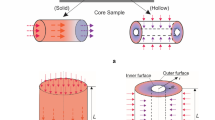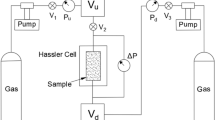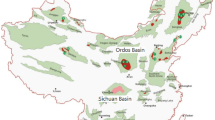Abstract
An evaluation of fluid flow behavior in porous media is necessary considering its widespread applications in geo-engineering projects, such as reservoir productivity and hydraulic fracturing. In order to improve the understanding of gas flow characteristics in porous media, particularly permeability estimation of unconventional gas reservoirs, various pressure transient measurement techniques were numerically evaluated in this study based on the established mathematical models, closely representing each experimental design of these transient techniques. Given that both compressive storage and sorption capacity of unconventional reservoirs vary at different pressures, the practicability of the conventional pulse decay method (PDM), initially adopted by Brace et al. (J Geophys Res 73(6):2225–2236, 1968), was examined. The results showed that compressive storage and sorption effect are the limiting factors in the application of the conventional PDM for permeability measurement of sorptive rocks. Meanwhile, the degree to which these factors affect the accuracy of pressure response and permeability were investigated quantitatively. It was found that pulse size, rock porosity, gas compressibility and reservoir volumes are the main parameters influencing compressive storage and sorption effect, and thus the application of the conventional PDM. A comprehensive numerical investigation was also conducted on Metwally and Sondergeld’s technique, a modified PDM, initially proposed for measuring low permeabilities of gas sands and shales. Considering limitations in the derived permeabilities of sorptive rocks when using the conventional PDM techniques and Metwally and Sondergeld’s technique, an optimized PDM was then proposed by creating dual-pressure pulses to avoid the pressure disturbance due to compressive storage, and ad-/de- sorption during the course of measurement. To verify the feasibility of the optimized PDM, a suite of numerical investigation was carried out for various PDM techniques, and the pressure responses were also compared with calculated data obtained from the mathematical model and experimental results. Both numerically calculated and experimental results exhibit the practicality of the optimized PDM, providing a fast, accurate and reliable approach for permeability measurement of sorptive rocks.













Similar content being viewed by others
References
Brace, W.F., Walsh, J., Frangos, W.: Permeability of granite under high pressure. J. Geophys. Res. 73(6), 2225–2236 (1968)
Cui, X., Bustin, A., Bustin, R.M.: Measurements of gas permeability and diffusivity of tight reservoir rocks: different approaches and their applications. Geofluids 9(3), 208–223 (2009)
Dicker, A., Smits, R.: A practical approach for determining permeability from laboratory pressure-pulse decay measurements. In: International Meeting on Petroleum Engineering 1988. Society of Petroleum Engineers
Feng, R., Harpalani, S., Liu, J.: Optimized pressure pulse-decay method for laboratory estimation of gas permeability of sorptive reservoirs: Part 2—Experimental study. Fuel 191, 565–573 (2017a). doi:10.1016/j.fuel.2016.11.077
Feng, R., Harpalani, S., Pandey, R.: Evaluation of various pulse-decay laboratory permeability measurement techniques for highly stressed coals. Rock Mech. Rock Eng. 50, 297–308 (2016a). doi:10.1007/s00603-016-1109-7
Feng, R., Harpalani, S., Pandey, R.: Laboratory measurement of stress-dependent coal permeability using pulse-decay technique and flow modeling with gas depletion. Fuel 177, 76–86 (2016b)
Feng, R., Liu, J., Harpalani, S.: Optimized pressure pulse-decay method for laboratory estimation of gas permeability of sorptive reservoirs: Part 1 - Background and numerical analysis. Fuel 191, 555–564 (2017b). doi:10.1016/j.fuel.2016.11.079
Hannon, M.J.: Alternative approaches for transient-flow laboratory-scale permeametry. Transp. Porous Med. (2016). doi:10.1007/s11242-016-0741-8
Harpalani, S., Prusty, B.K., Dutta, P.: Methane/CO\(_2\) sorption modeling for coalbed methane production and CO\(_2\) sequestration. Energy Fuel 20(4), 1591–1599 (2006). doi:10.1021/Ef0504341
Hsieh, P., Tracy, J., Neuzil, C., Bredehoeft, J., Silliman, S.: A transient laboratory method for determining the hydraulic properties of ‘tight’ rocks–I. Theory. Int J Rock Mech Min Sci Geomech Abst 3, 245–252 (1981)
Jones, S.: A technique for faster pulse-decay permeability measurements in tight rocks. SPE Form. Eval. 12(01), 19–26 (1997)
Kamath, J., Boyer, R., Nakagawa, F.: Characterization of core scale heterogeneities using laboratory pressure transients. SPE Form. Eval. 7(03), 219–227 (1992)
Lin, W.: Compressibility Fluid Flow Through Rocks of Variable Permeability. University of California, California (1977)
Lin, W.: Parametric analyses of the transient method of measuring permeability. J. Geophys. Res. Solid Earth (1978–2012) 87(B2), 1055–1060 (1982)
Liu, S., Harpalani, S.: Compressibility of sorptive porous media: Part 2. Experimental study on coal. Aapg Bull. 98(9), 1773–1788 (2014). doi:10.1306/03241413134
Metwally, Y.M., Sondergeld, C.H.: Measuring low permeabilities of gas-sands and shales using a pressure transmission technique. Int. J. Rock Mech. Min. 48(7), 1135–1144 (2011)
Mitra, A., Harpalani, S., Liu, S.: Laboratory measurement and modeling of coal permeability with continued methane production: Part 1-Laboratory results. Fuel 94(1), 110–116 (2012). doi:10.1016/j.fuel.2011.10.052
Palmer, I., Mansoori, J.: How permeability depends on stress and pore pressure in coalbeds: a new model. In: SPE Annual Technical Conference and Exhibition, Denvor, Colorado, USA 1996. Society of Petroleum Engineers
Pan, Z., Connell, L., Camilleri, M.: Laboratory characterisation of coal reservoir permeability for primary and enhanced coalbed methane recovery. Int. J. Coal Geol. 82(3), 252–261 (2010)
Sutherland, H., Cave, S.: Argon gas permeability of New Mexico rock salt under hydrostatic compression. Int. J. Rock Mech. Min. Sci. Geomech. Abst. 5, 281–288 (1980)
Walder, J., Nur, A.: Permeability measurement by the pulse-decay method: Effects of poroelastic phenomena and non-linear pore pressure diffusion. Int. J. Rock Mech. Min. Sci. Geomech. Abst. 3, 225–232 (1986)
Wang, Y., Liu, S., Elsworth, D.: Laboratory investigations of gas flow behaviors in tight anthracite and evaluation of different pulse-decay methods on permeability estimation. Int. J. Coal Geol. 149, 118–128 (2015)
Zhang, M., Takahashi, M., Morin, R., Esaki, T.: Evaluation and application of the transient-pulse technique for determining the hydraulic properties of low-permeability rocks—Part 2: experimental application. Geotech. Test. J. 23(1), 91–99 (2000)
Author information
Authors and Affiliations
Corresponding author
Rights and permissions
About this article
Cite this article
Feng, R., Pandey, R. Investigation of Various Pressure Transient Techniques on Permeability Measurement of Unconventional Gas Reservoirs. Transp Porous Med 120, 495–514 (2017). https://doi.org/10.1007/s11242-017-0936-7
Received:
Accepted:
Published:
Issue Date:
DOI: https://doi.org/10.1007/s11242-017-0936-7




